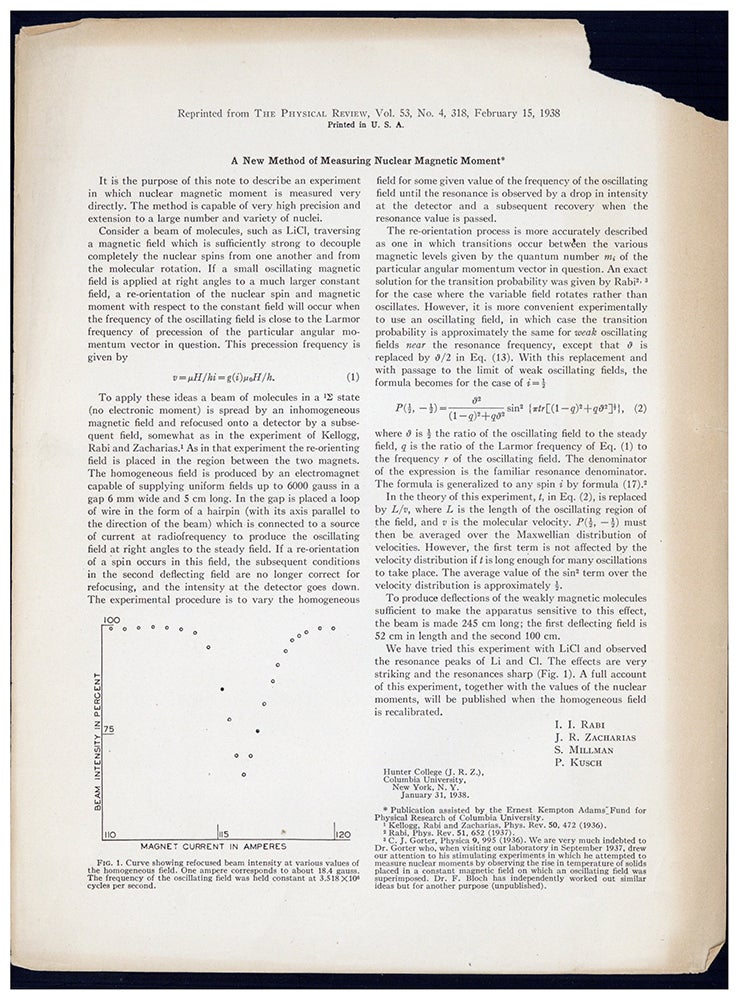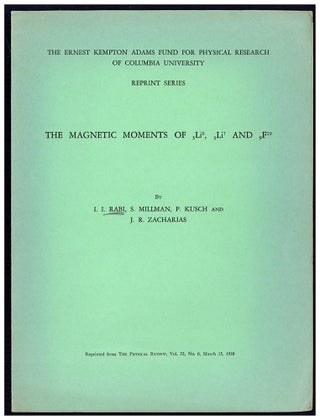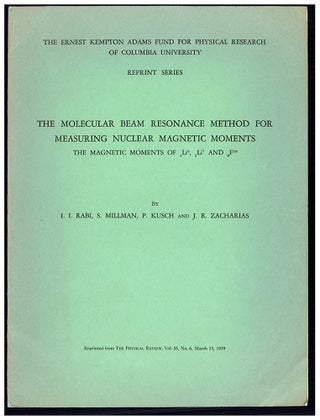1. A new method of measuring nuclear magnetic moment. 2. The magnetic moments of 3Li6, 3Li7, and 9F19. 3. The molecular beam resonance method for measuring nuclear magnetic moments. 3 offprints
Publisher Information: 1938-39. Rabi, Isidore I. (1898-1988); Sidney Millman (1904-2006); Polykarp Kusch (1911-93); Jerrold R. Zacharais (1905-86). (1) A new method of measuring nuclear magnetic moment. Offprint from Physical Review 53 (1938). Single sheet, unbound. 267 x 200 mm. Browned at edges, light fraying, piece missing from upper corner (not affecting text). (2) The magnetic moments of 3Li6, 3Li7, and 9F19. Offprint from Physical Review 53 (1938). [1] page. 267 x 200 mm. Original printed wrappers, slightly sunned, Rabi’s name underlined in pencil on front wrapper. (3) The molecular beam resonance method for measuring nuclear magnetic moments: The magnetic moments of 3Li6, 3Li7, and 9F19. Offprint from Physical Review 55 (1939). 526-535pp. 267 x 200 mm. Original printed wrappers, slightly sunned, lower corner lightly creased. Together 3 items. Very good.
First Editions, Offprint Issues of Rabi’s first papers on his resonance method of magnetic moment measurement, which earned him the Nobel Prize for physics in 1944. Rabi’s resonance method is not only of central importance in physics, but is also the foundation of magnetic resonance imaging (MRI), which revolutionized medical imaging in the last decades of the twentieth century.
Rabi received his doctorate in physics from Columbia University in 1927 and afterwards traveled to Europe to study physics with Niels Bohr, Wolfgang Pauli, Otto Stern and Werner Heisenberg. From Stern, Rabi learned the molecular-beam method, which appealed to him so much that he established his own molecular beam laboratory at Columbia in 1931, shortly after being appointed to the university’s physics faculty. Over the next few years Rabi refined his molecular-beam apparatus, working with a team that included future Nobel Laureate Polykarp Kusch. In 1937, after learning of the failed attempts of Dutch physicist Cornelis Gorter to detect nuclear magnetic resonance in solid matter, the Rabi team began their experimental investigations in earnest. As Norman Ramsey, then one of Rabi’s team members, writes:
"In September 1937, Gorter visited Rabi’s laboratory at Columbia University and described his brilliantly conceived but experimentally unsuccessful efforts to observe resonant heating of a substance in a strong static magnetic field when also subjected to a weak field oscillating at the precession frequency of the nucleus in the static field. Rabi then fully appreciated the advantage of using an oscillatory field and promptly invented the molecular beam magnetic resonance method. Two successful molecular beam magnetic resonance apparatuses were soon constructed by Rabi, J. R. Zacharias, S. Millman, and P. Kusch, and by J. M. B. Kellogg, Rabi, Ramsey and Zacharias . . . As expected, the first magnetic resonance was observed by Rabi, Zacharias, Millman and Kusch, who were studying the easily detected LiCl molecule" (Ramsey, p. 126).
In the spring of 1938 Rabi and his team published two short papers in the Physical Review (nos. [1] and [2] above) “report[ing] briefly on a new precision method of measuring nuclear moment, and on some results” (Rabi et al. [1939], p. 526). These were followed in 1939 by “The molecular beam resonance method for measuring nuclear magnetic moments: The magnetic moments of 3Li6, 3Li7, and 9F19” (no. [3] above), containing the first complete account of the Rabi team’s magnetic resonance experiments. N. Ramsay, “Early history of magnetic resonance,” Phys. Perspectives 1 (1999): 123-135. Rabi’s achievement is documented in detail in the first chapter of Mattson and Simon’s The Pioneers of NMR and Magnetic Resonance in Medicine: The Story of MRI (1996).
Book Id: 46008Price: $9,500.00



